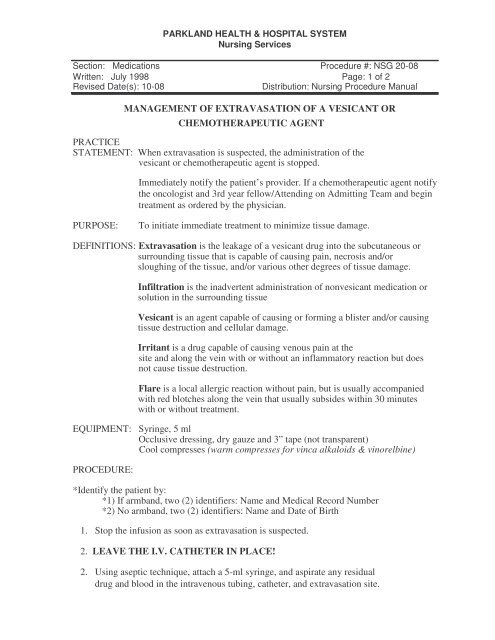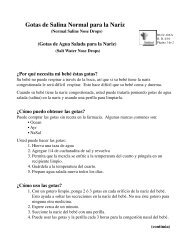practice management of extravasation of a vesicant or... - Parkland ...
practice management of extravasation of a vesicant or... - Parkland ...
practice management of extravasation of a vesicant or... - Parkland ...
You also want an ePaper? Increase the reach of your titles
YUMPU automatically turns print PDFs into web optimized ePapers that Google loves.
Section: Medications<br />
Written: July 1998<br />
Revised Date(s): 10-08<br />
PARKLAND HEALTH & HOSPITAL SYSTEM<br />
Nursing Services<br />
Procedure #: NSG 20-08<br />
Page: 1 <strong>of</strong> 2<br />
Distribution: Nursing Procedure Manual<br />
MANAGEMENT OF EXTRAVASATION OF A VESICANT OR<br />
CHEMOTHERAPEUTIC AGENT<br />
PRACTICE<br />
STATEMENT: When <strong>extravasation</strong> is suspected, the administration <strong>of</strong> the<br />
<strong>vesicant</strong> <strong>or</strong> chemotherapeutic agent is stopped.<br />
PURPOSE:<br />
Immediately notify the patient’s provider. If a chemotherapeutic agent notify<br />
the oncologist and 3rd year fellow/Attending on Admitting Team and begin<br />
treatment as <strong>or</strong>dered by the physician.<br />
To initiate immediate treatment to minimize tissue damage.<br />
DEFINITIONS: Extravasation is the leakage <strong>of</strong> a <strong>vesicant</strong> drug into the subcutaneous <strong>or</strong><br />
surrounding tissue that is capable <strong>of</strong> causing pain, necrosis and/<strong>or</strong><br />
sloughing <strong>of</strong> the tissue, and/<strong>or</strong> various other degrees <strong>of</strong> tissue damage.<br />
Infiltration is the inadvertent administration <strong>of</strong> non<strong>vesicant</strong> medication <strong>or</strong><br />
solution in the surrounding tissue<br />
Vesicant is an agent capable <strong>of</strong> causing <strong>or</strong> f<strong>or</strong>ming a blister and/<strong>or</strong> causing<br />
tissue destruction and cellular damage.<br />
Irritant is a drug capable <strong>of</strong> causing venous pain at the<br />
site and along the vein with <strong>or</strong> without an inflammat<strong>or</strong>y reaction but does<br />
not cause tissue destruction.<br />
Flare is a local allergic reaction without pain, but is usually accompanied<br />
with red blotches along the vein that usually subsides within 30 minutes<br />
with <strong>or</strong> without treatment.<br />
EQUIPMENT: Syringe, 5 ml<br />
Occlusive dressing, dry gauze and 3” tape (not transparent)<br />
Cool compresses (warm compresses f<strong>or</strong> vinca alkaloids & vin<strong>or</strong>elbine)<br />
PROCEDURE:<br />
*Identify the patient by:<br />
*1) If armband, two (2) identifiers: Name and Medical Rec<strong>or</strong>d Number<br />
*2) No armband, two (2) identifiers: Name and Date <strong>of</strong> Birth<br />
1. Stop the infusion as soon as <strong>extravasation</strong> is suspected.<br />
2. LEAVE THE I.V. CATHETER IN PLACE!<br />
2. Using aseptic technique, attach a 5-ml syringe, and aspirate any residual<br />
drug and blood in the intravenous tubing, catheter, and <strong>extravasation</strong> site.
Section: Medications<br />
Written: July 1998<br />
Revised Date(s): 10-08<br />
Procedure #: NSG 20-08<br />
Page: 2 <strong>of</strong> 2<br />
Distribution: Nursing Procedure Manual<br />
3. Notify the physician (if chemotherapy, oncologist and 3rd year fellow).<br />
Instill appropriate intravenous <strong>or</strong> subcutaneous antidote if <strong>or</strong>dered.<br />
4. Remove the peripheral catheter <strong>or</strong> implanted p<strong>or</strong>t needle. Have provider assess central line<br />
and D/C if needed.<br />
5. Measure the size <strong>of</strong> the <strong>extravasation</strong>.<br />
6. Cover infiltration site with a sterile occlusive dressing. Do not use transparent dressings.<br />
7. Apply cool compresses f<strong>or</strong> the first 72 hours f<strong>or</strong> 15-20 minutes minimally, four times a<br />
day. Use warm compresses f<strong>or</strong> infiltration <strong>of</strong> vinca alkaloids (Vincristine, Vinblastine,<br />
Vin<strong>or</strong>elbine).<br />
8. Elevate the extremity.<br />
9. Inpatient areas: observe the site a minimum <strong>of</strong> every 8 hours f<strong>or</strong> erythema, induration and/<strong>or</strong><br />
necrosis, and, assess f<strong>or</strong> increasing local pain and tenderness.<br />
10. F<strong>or</strong> patients in the clinics, schedule a follow-up examination by the physician within<br />
24 to 72 hours following <strong>extravasation</strong>. Instruct patient to rep<strong>or</strong>t and changes and follow<br />
up sooner if needed.<br />
11. Patient may require Plastic Surgery Consult.<br />
12. Complete an online (PSN) event rep<strong>or</strong>t.<br />
13. Rec<strong>or</strong>d on the Nurses Notes the date, time, catheter <strong>or</strong> needle size and type, insertion site,<br />
drug sequence, drug administration technique, approximate amount <strong>of</strong> drug,<br />
size <strong>of</strong> <strong>extravasation</strong>, appearance <strong>of</strong> site, name <strong>of</strong> physician notified, patient’s complaints<br />
and statements and any follow-up treatments/measures.<br />
NOTE: Not all <strong>vesicant</strong>/ irritant agents are listed below. Some agent’s reactions are dose dependent.<br />
Consult drug guides and/<strong>or</strong> Pharmacy f<strong>or</strong> suspected <strong>extravasation</strong>.<br />
VESICANT AGENTS IRRITANT AGENTS EXAMPLES<br />
Dactinomycin<br />
Daun<strong>or</strong>ubicin<br />
Dox<strong>or</strong>ubicin<br />
Epirubicin<br />
Idarubicin<br />
Mechl<strong>or</strong>ethamine (Nitrogen Mustard)<br />
Mitomycin<br />
Mitoxantrone<br />
Vinblastine<br />
Vin<strong>or</strong>elbine<br />
Vincristine<br />
Lexi-Comp Online- Management <strong>of</strong> Extravasations<br />
http://www.crlonline.com/crlsql/servlet/crlonline<br />
Carboplatin<br />
Carmustine<br />
Cisplatin<br />
Dacarbazine<br />
Daun<strong>or</strong>ubicin Liposomal<br />
Dox<strong>or</strong>ubicin Liposomal<br />
Etoposide<br />
Ifosfamide<br />
Streptozocin<br />
Oxaliplatin<br />
Paclitaxel





